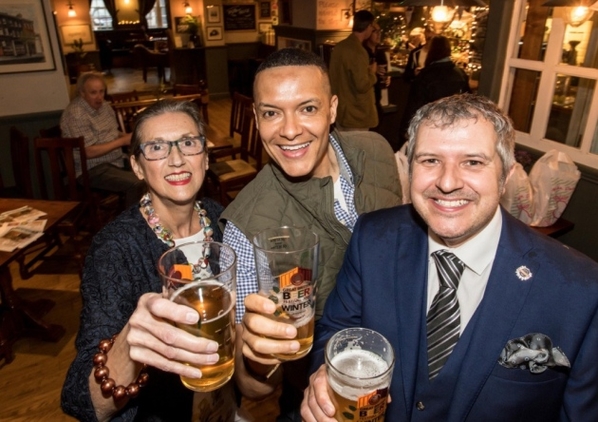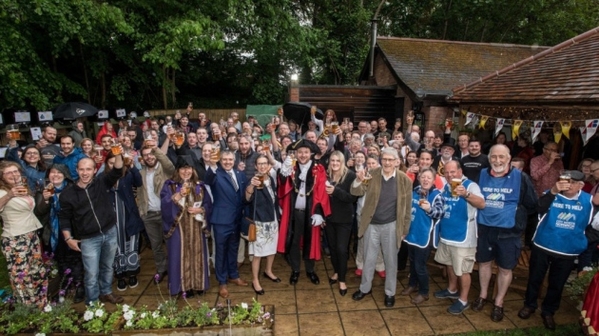City of Ale: the speech I didn't make...
Added: Friday, May 25th 2018

The crowd should have sung “The man that watered the workers’ beer” at the launch party for City of Ale on 24 May. We gathered in the large beer garden of the Black Horse in Norwich, close to the Roman Catholic cathedral, and the heavens dutifully opened.
A small stage had been erected in the garden where City of Ale organiser Dawn Leeder, the Lord Mayor of Norwich and I were due to speak. But the rain was torrential and drinkers sheltered in the pub and, with Morris Dancers performing their noisy bucolic rituals, the speeches were abandoned.
But, undaunted, this is what I planned to say:
This is the eighth year of City of Ale, a beer festival like no other, which has broken all the rules. It’s not a static festival but a series of rolling events that emphasise the crucial role played by the pub and attract a wide and diverse audience.
Other cities have clambered on the bandwagon. Derby and Sheffield both claim they are “cities of ale” but Norwich iz number one -- closely followed by St Albans!
The second half of my week has been as follows: Wednesday, Cambridge Beer Festival followed by three days at City of Ale. Tony Bennett may have lost his heart in San Francisco but I’m recording a song called I Left my Liver in East Anglia.
There’s so much enthusiasm for great beer today. The first edition of the Good Beer Guide in 1974 listed 116 breweries. Today there are 2,000 British breweries producing an amazing variety of beers. In that first GBG most brewers produced just mild and bitter. Today there are more styles than you can wave a stick at, with the latest buzz beers being Saison or Belgian farmhouse beer, and Sour, based on Belgian lambic.
IPA – India Pale Ale – is a world-wide phenomenon. IPA was to all intents and purposes dead and buried during World War One but it’s undergone an astonishing revival. When I published a book about IPA last year I found it was brewed not only in Britain and the U.S. but in such unlikely countries as France, Italy, Sweden, Denmark, Finland, China, Japan, Australia and New Zealand. It’s now a global style.
The Cambridge festival was a revelation. You can forget all the clichés about beards and sandals – this was a CAMRA festival drawing a vast audience of men and women of all ages. When I arrived for the evening session at 5 o’clock there was already a long queue on Jesus Green and when I went through the members’ entrance I was followed by a large number of young members of the campaign. The festival lasts for six days – one more day than the Great British Beer Festival – and is expected to attract around 450,000 visitors. Of course, no one wants to drink real ale today!
There’s a downside to the success of good beer from the artisan or craft movement. It’s attracted the attention of the global giants such AB InBev, Carlsberg and Heineken. SAB Miller, before it was swallowed by AB InBev, paid an astonishing £120 million for Meantime in London while InBev bought Camden Town for £80 million.
If you walk along the supermarket beer lines, do you think Goose Island is still a small micro in Chicago? No, it’s now part of AB InBev and is brewed in Canada, at a giant brewery in Fort Collins and a new brewery specially built for the brands in New York State. Lagunitas is no longer a California independent but is wholly owned by Heineken.
But the beer revolution is unstoppable and is producing not only new styles but also challenges. It has had an impact on CAMRA. As you know, the campaign has been through a long and at time painful re-evaluation of its role called the Revitalisation Programme. When an organisation of 192,000 members is more than 45 years old, it’s sensible to take a long, hard look to see if you’re fit for purpose in the 21st century. I fully supported Revitalisation but why did it take so long to reach its conclusions? Six Italian governments have fallen while Revitalisation was grinding on. But now CAMRA is facing up to the new reality of the modern world of beer.
When I arrived at the Norwich CAMRA beer festival last October, I was taken to the room where I was giving a talk and handed a glass of beer as a refresher. I said: “That’s superb. Who brewed it?” The local CAMRA person – no names, no pack drill – replied: “Cloudwater”.
“But they don’t brew at any cask beer.” I said loyally. Back came the response, “but it’s good, isn’t it?”
That’s the point: it’s good beer.
I went to Adnams a couple of weeks ago and I asked head brewer Fergus Fitzgerald about his new craft keg beers. He said they’re not filtered or pasteurised and the CO2 level is 2psi or pounds per square inch. Apart from being served slightly cooler, they are no different to cask ale. We’re not talking Watney’s Red or Double Diamond!
As you may know, the 2018 Good Beer Guide is the last one I’m editing. It’s been an exciting time to see the guide grow over the years, reflecting Britain’s dynamic beer scene.
And it’s called the Good Beer Guide, not the Good Real Ale Guide.
Long may good beer flourish, and thanks to Dawn and Phil and every one at City of Ale for being such brilliant flag bearers for good beer.
Pictures: top, Dawn Leeder and Phil Cutter, founders of City of Ale, with Clive Lewis, Member of Parliament for Norwich South, (centre) at the launch party. Below, the crowd dodges the rain at the Black Horse.









